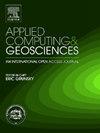Evaluating the performances of SVR and XGBoost for short-range forecasting of heatwaves across different temperature zones of India
IF 3.2
Q2 COMPUTER SCIENCE, INTERDISCIPLINARY APPLICATIONS
引用次数: 0
Abstract
This research aims to forecast maximum temperatures and the frequency of heatwave days across four different temperature zones (Zone 1, 2, 3 and 4) in India. These four zones are categorized based on the 30-year average maximum temperatures (T30AMT) during the summer months of April, May, and June (AMJ). Two Machine Learning (ML) algorithms eXtreme Gradient Boosting (XGBoost) and Support Vector Regression (SVR) are employed to achieve this goal. The study utilizes nine key atmospheric variables namely air temperature, geopotential height, relative humidity, U-wind, V-wind, soil moisture, solar radiation, sea surface temperature, and mean sea level pressure at a daily scale spanning from 1991 to 2020 for the months of March, April, May, and June as predictors. The India Meteorological Department daily maximum temperature data spanning from 1991 to 2020 for the months of AMJ serves as the predictands. ML models are developed using spatially averaged atmospheric variables and daily maximum temperature across the grids falling within each temperature zone. Results indicate that for a 7-day lead time, SVR outperforms XGBoost in Zone-1 (T30AMT > 38 °C) and Zone-2 (T30AMT: 35.01 °C–38 °C) by more accurately capturing peak temperatures during training and testing. Conversely, for a 15-day lead time in Zone-1, XGBoost better predicts temperature peaks in both phases. In Zone-3 (T30AMT: 30 °C–35 °C) and Zone-4 (T30AMT < 30 °C) for both lead times, the performance of both models decline, indicating models and input variables are more effective in predicting higher temperatures typical of Zone-1 and 2 but less so in Zone-3 and 4. In a nutshell, the study attempts to highlight the capability of advanced ML techniques combined with spatial climate data to enhance the prediction of extreme heatwave events. These insights can aid in heatwave preparedness, climate management, and adaptation strategies for different Indian temperature zones.
评估 SVR 和 XGBoost 在印度不同温度带热浪短程预报中的性能
本研究旨在预测印度四个不同温度区(1、2、3 和 4 区)的最高气温和热浪日频率。这四个区域是根据四月、五月和六月(AMJ)夏季的 30 年平均最高气温(T30AMT)划分的。为实现这一目标,采用了两种机器学习(ML)算法:梯度提升算法(XGBoost)和支持向量回归算法(SVR)。该研究采用了九个关键大气变量作为预测因子,即 1991 年至 2020 年 3 月、4 月、5 月和 6 月每日的气温、位势高度、相对湿度、U 风、V 风、土壤湿度、太阳辐射、海面温度和平均海平面气压。印度气象局 1991 年至 2020 年 AMJ 月份的日最高气温数据作为预测因子。利用空间平均大气变量和每个气温区域内网格的日最高气温开发了 ML 模型。结果表明,在 7 天的前导时间内,SVR 在 1 区(T30AMT > 38 ℃)和 2 区(T30AMT: 35.01 ℃-38 ℃)的表现优于 XGBoost,因为 SVR 能更准确地捕捉到训练和测试期间的峰值温度。相反,在前导时间为 15 天的 1 区,XGBoost 能更好地预测两个阶段的温度峰值。在第 3 区(T30AMT:30 °C-35 °C)和第 4 区(T30AMT < 30 °C),在两个提前期,两个模型的性能都有所下降,表明模型和输入变量在预测第 1 区和第 2 区典型的较高温度时更为有效,但在第 3 区和第 4 区则效果较差。总之,这项研究试图强调先进的 ML 技术与空间气候数据相结合的能力,以加强对极端热浪事件的预测。这些见解有助于印度不同温区的热浪防范、气候管理和适应战略。
本文章由计算机程序翻译,如有差异,请以英文原文为准。
求助全文
约1分钟内获得全文
求助全文
来源期刊

Applied Computing and Geosciences
Computer Science-General Computer Science
CiteScore
5.50
自引率
0.00%
发文量
23
审稿时长
5 weeks
 求助内容:
求助内容: 应助结果提醒方式:
应助结果提醒方式:


